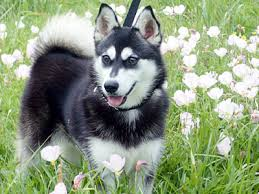Alaskan Klee Kai

Description
An extremely rare breed, the Alaskan Klee Kai is a smaller version of the Alaskan Husky; it was designed to be a companion version of the great sled dogs of the north. It was developed in the 1970s by Linda S. Spurlin of Wasilla, Alaska, and her family, and made available to the public in 1988. The United Kennel Club recognized it as a breed in 1997.
Klee Kai is derived from the Eskimo words for “little dog.” It was originally called Klee Kai of Alaska, but later became just Alaskan Klee Kai. The Alaskan Klee Kai has a wedge-shaped head and a distinguishing masked face.
Because of the small numbers and careful breeding, there are few health concerns with this breed. This agile and active companion dog has a personality full of curiosity, alertness and loyalty. It loves to be around the family, sharing its affection and energy, but might be a little reserved with strangers. Although you don’t need a lot of indoor room (so an apartment would be OK for this breed, but not preferred), you will need lots of time to exercise this dog. With lots of energy comes lots of time spent burning it off. Don’t let its small stature fool you; the Alaskan Klee Kai can make a great watchdog.
Group
Rare
Country Of Origin
USA
Size
Small Dog Breed
Color
Alaskan Klee Kai come in three recognized color varieties: black and white, gray and white, or red and white (which may appear as a cinnamon or a dark auburn). Solid white Alaskan Klee Kai also exist but this coat color variety is considered a disqualification by the breed standard. Solid white Alaskan Klee Kai have just recently become recognized by the United Kennel Club and may be registered but not shown competitively.
Coat
There are also two coat types found in the breed. These consist of the standard and full-coated varieties. Both are recognized by the UKC and equally acceptable by the breed standard. The only exception being that the coat length may not be so long as to obscure the outline of the dog, which is considered a breed fault. The Alaskan Klee Kai has a double coat; an undercoat that is short and soft and an outer coat that is made of longer guard hairs. This double coat allows them to have thermal protection from extreme hot and cold weather.
Grooming
Like the Siberian Husky, the Alaskan Klee Kai typically requires relatively easy care. They are extremely clean. Most do not like wet feet and will spend hours daily grooming themselves. Alaskan Klee Kai, like many other northern breeds, do not have a typical "doggy odor" or "doggy breath." Most Klee Kai will seldom require a bath. They are rather efficient, so no grooming is needed. An Alaskan Klee Kai should not be shaved unless for medical reasons. They need their coat to keep them cool and to protect their skin.
Also like Siberians (and unlike short haired dogs who shed all year), the Klee Kai blows its coat twice a year, while they also shed continuously during the year. Of course, the size of the dogs limits the amount of fur blown. It is best to groom the dog on a regular basis during this time. Some of the longer haired dogs can become matted if not groomed. Most Klee Kai will assist the loss of hair by rubbing against things such as fences. Other than this period of blowing coat, the Klee Kai is very self-sufficient. The normal preventative measures should be taken, such as trimming of nails, normal grooming in the form of brushing. This process is especially important in the bonding process.
Life Expectancy
10 to 13 years
AKC Group
Rare
UKC Group
Northern Breed
Height
According to breed standards, an adult Alaskan Klee Kai should be between 13 and 17 inches in height.
Toy Variety: Up to and including 13 in (33 cm)
Miniature Variety: Over 13 in (33 cm) and up to and including 15 in (38 cm).
Standard Variety: Over 15 in (38 cm) up to and including 17 in (43 cm).
Serious Fault: Over 17 in (43 cm) up to and including 17.5 in (44 cm).
Eliminating Fault: Over 17.5 in (44 cm) in height.
Weight
They can be toy, miniature, or standard variety and weigh between 5 and 22 lbs
Use Today
Companion